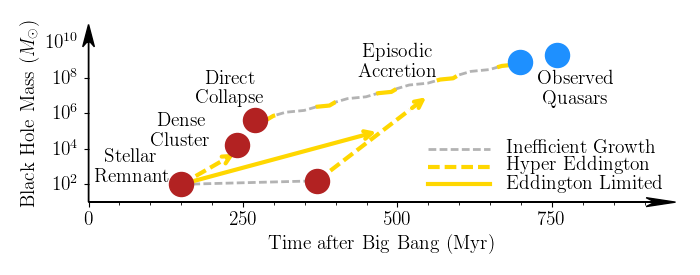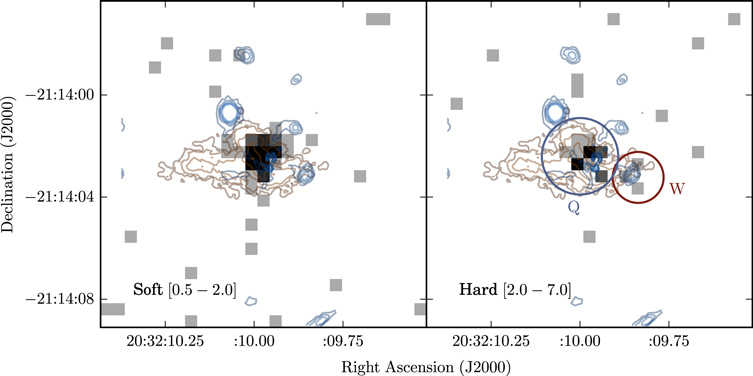Studying the Titans of the Early Universe with X-rays
Relevant Works: Bañados, Connor et al., 2018; Connor et al., 2019d; Connor et al., 2020
 The presence of black holes with masses in the billions of Solar masses
observed only hundreds of millions of years after the Big Bang (e.g.,
Yang et al. 2020) sets
a challenge for modern cosmology: how can these objects grow to such
massive sizes in such a short time? Hundreds of supermassive black
holes (SMBHs) have now been observed in the first billion years of the
universe (e.g.,
Bañados et al. 2016), clearly establishing the expected
results from early growth.
Conversely, the masses and formation times of seeds can only be
hypothesized, as these objects remain outside of the capabilities of
current observatories to detect. To connect observations to theory,
we therefore turn to measurements of the growth history of these objects;
smaller or later-forming seeds can only be explained if growth rates
exceed the Edington Limit. X-ray observations, which are sensitive
to the inner regions of Active Galactic Nuclei (AGN) are a fundamental
tool for these measurements.
The presence of black holes with masses in the billions of Solar masses
observed only hundreds of millions of years after the Big Bang (e.g.,
Yang et al. 2020) sets
a challenge for modern cosmology: how can these objects grow to such
massive sizes in such a short time? Hundreds of supermassive black
holes (SMBHs) have now been observed in the first billion years of the
universe (e.g.,
Bañados et al. 2016), clearly establishing the expected
results from early growth.
Conversely, the masses and formation times of seeds can only be
hypothesized, as these objects remain outside of the capabilities of
current observatories to detect. To connect observations to theory,
we therefore turn to measurements of the growth history of these objects;
smaller or later-forming seeds can only be explained if growth rates
exceed the Edington Limit. X-ray observations, which are sensitive
to the inner regions of Active Galactic Nuclei (AGN) are a fundamental
tool for these measurements.
One potential avenue of exploration is in the X-ray spectral properties of these AGN. A statistical link has been found between the characteristic spectral index of the power law component of X-ray emission (Γ) and the underlying SMBH accretion rate for quasars (e.g., Brightman et al., 2013), such that steeper values of Γ correspond to higher accretion rates. Several works, notably Nanni et al. 2017, Vito et al. 2019b, and Wang et al. 2020, have looked for evidence of changes in the distribution of Γ values for high-redshift quasars, but the limitations of low photon counts makes this prone to large statistical errors. As I discuss in Connor et al. 2020, in the low count regime, a meaningful measurement of quasar properties is difficult when most of the rest-frame X-ray emission has been redshifted out of the observable bands.
To avoid the limitations of statistical studies of large populations of quasars, I have turned to observing promising individual quasars, which can have indirect evidence pointing toward significant amounts of accretion. Recent works have identified companion galaxies through ALMA imaging of redshifted [C II] (158 micron) emission around multiple high redshift quasars (starting with Decarli et al. 2017). If these companion galaxies—which, based on the presence of signifcant [C II] emission, are rapidly forming stars—are also host to AGN, the inevitible SMBH mergers will generate a significant one-time growth to the originally-detected quasar's mass. Thus, I have searched for X-ray signatures from these companion galaxies.
 PJ 308−21 is the most promising of these targets. ALMA/HST observations
of this system by
Decarli et al. 2019 showed that there is a companion galaxy
actively merging with the quasar host galaxy. In the X-ray observations,
shown at right, we see evidence for a hard X-ray source coincident
with a UV knot, just where we would expect it to be if there is a
companion AGN involved in the merger. The hardness of the source
implies that it is heavily obscured. Of course, this observation
took Chandra to its limits, and even with deep observations
the significance of this detection is only P=0.979. Other attempts
to detect AGN companions at these redshifts in X-rays—
Vito et al. 2019a and
Connor et al. 2020—have had less successful results.
PJ 308−21 is the most promising of these targets. ALMA/HST observations
of this system by
Decarli et al. 2019 showed that there is a companion galaxy
actively merging with the quasar host galaxy. In the X-ray observations,
shown at right, we see evidence for a hard X-ray source coincident
with a UV knot, just where we would expect it to be if there is a
companion AGN involved in the merger. The hardness of the source
implies that it is heavily obscured. Of course, this observation
took Chandra to its limits, and even with deep observations
the significance of this detection is only P=0.979. Other attempts
to detect AGN companions at these redshifts in X-rays—
Vito et al. 2019a and
Connor et al. 2020—have had less successful results.